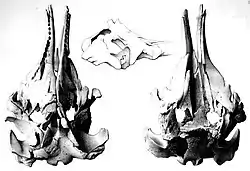Diaphorocetus
Diaphorocetus is an extinct genus of odontocete cetacean belonging to Physeteroidea. Its remains were found in the Monte León Formation of Argentina, dating to the Early Miocene.[1]
| Diaphorocetus | |
|---|---|
 | |
| Diaphorocetus poucheti skull | |
| Scientific classification | |
| Kingdom: | Animalia |
| Phylum: | Chordata |
| Class: | Mammalia |
| Order: | Artiodactyla |
| Infraorder: | Cetacea |
| Superfamily: | Physeteroidea |
| Family: | incertae sedis |
| Genus: | †Diaphorocetus Ameghino, 1894 |
| Species | |
|
D. poucheti (type) | |
| Synonyms | |
| |
Systematics
Diaphorocetus was originally named Mesocetus by Moreno (1892).[2] Lydekker (1893) found that Mesocetus was already in use for an extinct mysticete, so he renamed the sperm whale Hypocetus.[3] Ameghino (1894) too recognized Moreno's name as preoccupied, but unaware of Lydekker's paper, coined his own replacement name Diaphorocetus for Mesocetus.[4] Diaphorocetus was declared a nomen protectum (protected name) by Paolucci et al. (2019) because Hypocetus and Paracetus have not been used as valid since 1899 under Article 23.9 of the Code.[5]
Paleoecology
The small teeth of Diaphorocetus and the bottleneck-like nature of the rostrum suggest that Diaphorocetus employed a feeding strategy intermediate between that of raptorial sperm whales like Acrophyseter and Livyatan and extant sperm whales.[5]
References
- Diaphorocetus at Fossilworks.org
- Moreno, F. P. 1892. Lijeros apuntes sobre dos generos de cetaceos fosiles de la Republica Argentina. Revista de la Museo La Plata 3, 393–400.
- Lydekker, R. 1893 [1894]. Cetacean skulls from Patagonia. Anales del Museo de la Plata 2: 1–13.
- Ameghino, F. 1894. Enum�eration synoptique des especes de mammiferes fossiles des formations �eocenes de Patagonie. Boletin de la Academia Nacional de Ciencias en C�ordoba 13: 259–455
- Florencia Paolucci, Mónica R. Buono, Marta S. Fernández, Felix G. Marx & José I. Cuitiño (2019). Diaphorocetus �poucheti (Cetacea, Odontoceti, Physeteroidea) from Patagonia, Argentina: one of the earliest sperm whales, Journal of Systematic Palaeontology, DOI:10.1080/14772019.2019.1605544